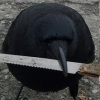What do you do when trying to describe something very specific?
Many times when writing, I get a very specific image in my head of the way I want something to look, or the way I want something to move. Particularly with actions where objects are moving in a very specific way, I want to describe them accurately so that most readers would see the same thing that I’m seeing in my head. The problem is, I don’t want to come off as sounding too technical (the object slid along its Z axis and suddenly stopped and rotated 45 degrees on its Y axis), and I also don’t want to be so vague that a later sentence contradicts what they were seeing in their head.
Is this just a psychological thing that I need to get over and stop worrying about, and just write to the best of my ability and edit when I hear critiques/comments from readers, or is it a skill that I need to improve?




Add comment